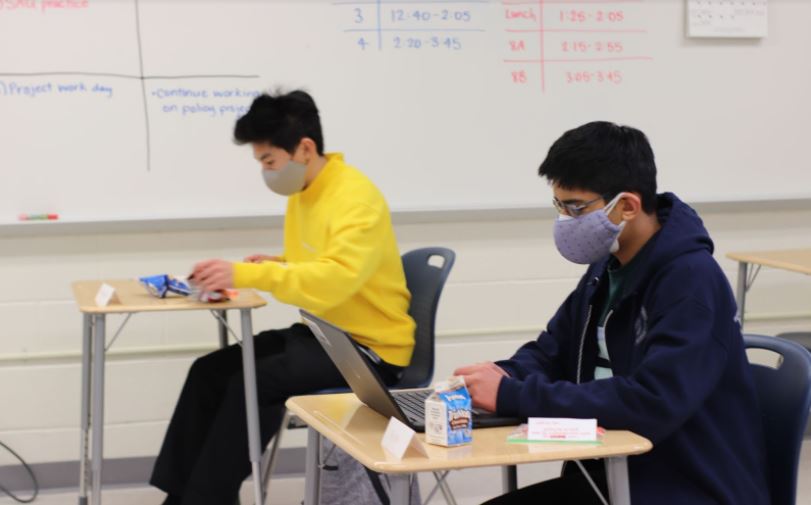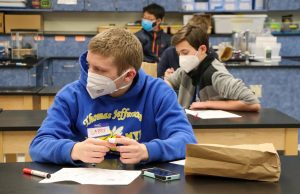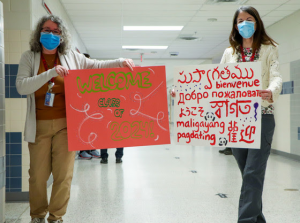Four-Day Plan: Four Times the Amount of Covid-19 Cases
FCPS should ramp up COVID precautions as spring weather approaches
Sitting six feet apart, hybrid students attend class for two days a week. FCPS plans to expand this option for students that need academic help to attend school in-person for four days a week. However, as students participate in more social gatherings during this warm weather, FCPS should be providing more precautions to identify and limit the spread of the virus instead of focusing on a new four-day plan.
April 16, 2021
With the Center for Disease Control and Prevention (CDC) recommending to decrease social distancing in low transmission zones, schools across the district have found classrooms with more openings for students to come back. Thus, Fairfax County Public Schools (FCPS) plans to expand options for students who are experiencing the greatest learning challenges. Starting April 20, the county will offer four days of in-person learning for these students.
With spring around the corner, I believe FCPS should not be implementing a four-day plan, but rather putting forth an increased number of guidelines for students in the hybrid plan. Warmer weather means more gatherings for middle and high school students that are tired of being cooped in their houses. Students want to get out of the house and go to places where they are much more prone to catch the virus. This creates more transmission when they carry the virus from home to school.
Additionally, the plan for the current school year should take into account the vaccination period. Despite the availability of the vaccine for upperclassmen this April, freshmen and many sophomores won’t have access to this protection as the FDA has only approved the vaccine for 16-year-olds and above. Furthermore, the long wait times and an overbooking of vaccine appointments mean the chances of a 16-year-old student getting a vaccine in a timely manner are very low.
The CDC recommends that there should be three feet of social distance for low to moderate transmission zones, and six feet of social distance for high transmission zones where cohorting is not possible. In an interview by CBS about the fourth wave, former FDA commissioner Scott Gotlieb said, “What we’re seeing is pockets of infection around the country, particularly in younger people who haven’t been vaccinated and also in school-age children. If you look at what’s happening in Michigan and Minnesota and Massachusetts, for example, you’re seeing outbreaks in schools.” Schools need to use six feet of social distance at front doors in preparation for a spring surge in cases that will likely increase FCPS’ transmission rate from substantial to high.
Temperature checks are also a crucial method to ensure that any student with a high temperature is sent home immediately, or securely placed in a separate part of the building until a parent can pick them up. While temperature isn’t a 100 percent accurate measure of identifying someone who has contracted the virus, it serves as another precaution.
It is important to ensure that our students stay safe in the final stretch of the school year. By increasing social distancing measures past three feet guidelines and implementing onsite temperature checks, we can improve upon the current two-day plan for our students.
If the purpose of education is to provide a fundamental benefit to our students, how can we neglect our students by threatening their health without appropriate precautions? Our schools need to ensure new plans are not introduced before making sure students are safe in the current environment.









